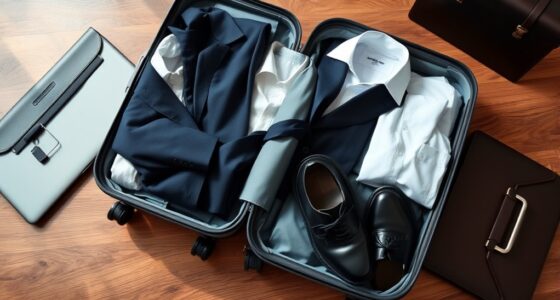When packing for adventure travel, focus on layering clothing with moisture-wicking bases, insulating mid-layers, and waterproof shells. Bring sturdy footwear suited for your activities, plus navigation and communication devices like GPS or radios, with extra batteries or portable chargers. Pack safety and first aid essentials along with plenty of water and nutritious snacks to stay energized. Include shelter and sleeping gear, weather protection items, and lighting sources. Keep items organized to maximize space. If you continue, you’ll discover key tips to make your outdoor gear practical and efficient.
Key Takeaways
- Use layered clothing with moisture-wicking fabrics, insulating layers, and waterproof shells to adapt to changing weather conditions.
- Pack essential navigation, communication, and lighting devices, ensuring they are durable, fully charged, and complemented by backup power sources.
- Include first aid supplies, hydration tools, and nutritious snacks to maintain safety, hydration, and energy levels during outdoor activities.
- Choose lightweight, durable shelter and sleeping gear, organizing items with packing cubes and compression bags for space efficiency.
- Maintain an organized packing system with essentials easily accessible, reviewing your list regularly to ensure completeness and avoid overpacking.
Essential Clothing and Footwear

When packing for adventure travel, choosing the right clothing and footwear is essential to staying comfortable and prepared for any situation. Focus on layering techniques to adapt to changing weather and activity levels. Start with moisture-wicking fabrics close to your skin—they pull sweat away and keep you dry, preventing chafing and chills. Add insulating layers like fleeces or lightweight down jackets for warmth, and top it off with a waterproof shell to protect against rain and wind. Your footwear should be sturdy, supportive, and suited to your planned activities, whether hiking boots or trail shoes. Proper socks made from moisture-wicking materials also help prevent blisters and keep your feet dry. Incorporating appropriate footwear and clothing options based on your environment can significantly enhance your comfort and safety during outdoor adventures. Using layering techniques ensures you can adjust your clothing to the changing conditions effectively. Additionally, paying attention to water requirements for large plants can help maintain a healthy environment if you’re traveling with plants or planning to set up outdoor plant displays. Being aware of climate considerations can also help you select the most suitable clothing and gear for your destination. Proper clothing care can extend the life of your gear, ensuring it remains functional and reliable during your travels. With the right combination, you’ll stay comfortable, dry, and ready for whatever your adventure throws at you.
Navigation and Communication Devices
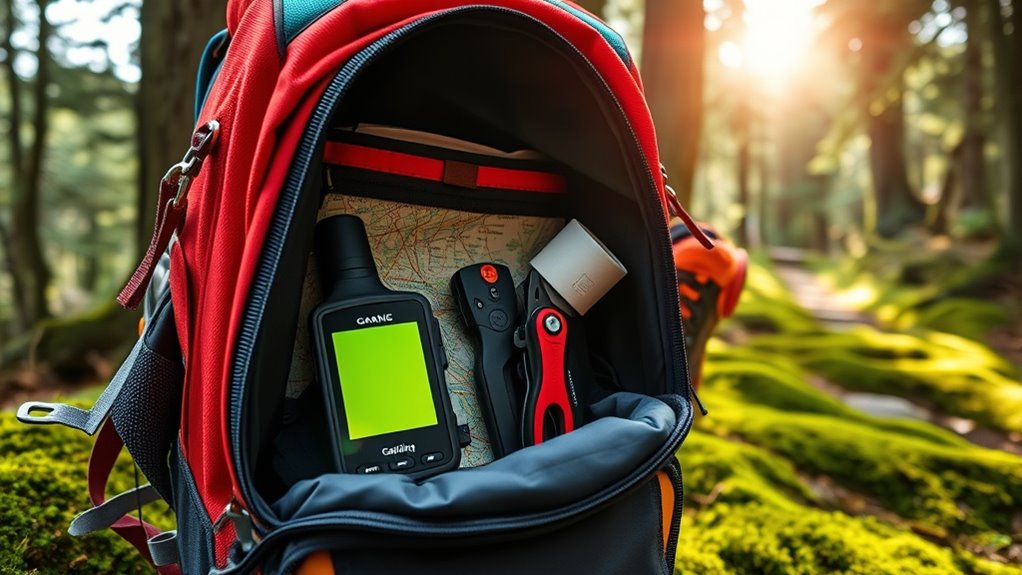
Having reliable navigation and communication devices is essential for safe and successful adventure travel. GPS devices help you stay on track, even in remote areas with poor cell service, ensuring you don’t get lost. Make sure your GPS is fully charged, and consider bringing extra batteries or a portable charger. Communication radios are also crucial for staying in contact with your group, especially in rugged terrain where cell signals may fail. Choose compact, durable radios with clear sound quality. Familiarize yourself with how to operate these devices before your trip to avoid confusion in critical moments. Properly functioning navigation and communication tools boost your confidence and safety, allowing you to focus on the adventure ahead without worry. Additionally, understanding the importance of contrast ratio can help you select devices with displays that remain clear and visible in various lighting conditions, enhancing your overall experience. Being aware of time zone differences can also prevent confusion when coordinating plans across different regions. Moreover, paying attention to device durability ensures your equipment withstands harsh outdoor environments and rough handling during adventures. Regularly checking the Wi-Fi connection of your devices can prevent unexpected disconnections, especially in remote areas. To further enhance your preparedness, consider hydration management strategies to stay energized and alert throughout your journey.
Safety and First Aid Supplies

Ensuring you carry proper safety and first aid supplies is essential for handling emergencies during your adventure. Being prepared can make all the difference in critical moments. Your kit should include essentials like bandages, antiseptic wipes, pain relievers, and tweezers. Consider taking a basic first aid training course to boost your confidence and response skills. Emergency preparedness also means knowing how to use your supplies effectively. Pack items such as:
- Adhesive bandages and gauze
- Antiseptic ointments and wipes
- Pain relievers and antihistamines
- Tweezers and scissors
- Emergency blanket or thermal wrap
- Regular use of first aid supplies can significantly improve your ability to respond to minor injuries or unexpected situations, keeping you safe and confident during your outdoor adventure. Understanding wound care techniques can further enhance your readiness in critical moments, especially given the importance of AI safety measures in modern safety protocols.
Hydration and Nutrition Gear

Make sure you pack portable water containers to stay hydrated on the go, and include energy-boosting snacks to keep your energy up. Hydration reminder devices can help you remember to drink regularly during active days. With these essentials, you’ll stay fueled and refreshed throughout your adventure. Considering best men’s cologne recommendations can also enhance your overall experience by helping you feel confident and fresh during your trip.
Portable Water Containers
Choosing the right portable water container can make all the difference on your adventure. To find the best fit, consider durability testing results and material comparisons. Look for containers made from sturdy, lightweight materials that withstand drops and rough handling. Assess if the container’s design prevents leaks and is easy to clean. A good water container should be leak-proof, BPA-free, and resistant to odors. Check for features like wide mouths for easy filling and drinking, and secure lids for transport. Additionally, consider capacity based on your hydration needs. Picking a container with high durability ensures it can endure rugged outdoor conditions. Also, selecting a container with easy cleaning features can help maintain hygiene during extended trips. Incorporating leak-proof technology further guarantees your belongings stay dry and your water stays contained. For added peace of mind, choosing a container with robust construction can prevent damage during transport. Evaluating material quality is essential to ensure long-term performance and safety. Choosing wisely guarantees you stay hydrated without adding unnecessary weight or risk of damage. Keep these factors in mind to select a reliable, durable, and convenient water container for your outdoor journey.
Energy-Boosting Snacks
Having a reliable energy-boosting snack on hand keeps you fueled during your adventure, especially when your portable water container is keeping you hydrated. Pack easy-to-carry options like energy bars and trail mix to maintain your energy levels on the trail. Energy bars provide concentrated calories and nutrients, perfect for quick boosts between breaks. Trail mix offers a mix of nuts, dried fruit, and seeds, giving you sustained energy and essential fats. These snacks are lightweight, durable, and require no preparation, making them ideal for outdoor activities. Keep a variety on hand to prevent boredom and ensure you’re prepared for any hike’s length or difficulty. Incorporating fermented foods can further support your gut health and boost your immune system while on the go. Staying energized helps you push through challenging sections and fully enjoy your outdoor experience. Additionally, choosing snacks with proper storage ensures they remain fresh and safe throughout your trip. Proper fuel‑storage is essential to prevent spoilage and ensure your snacks stay fresh during extended trips. Being mindful of identifying ripe produce can help you select the freshest ingredients to keep your snacks both tasty and nutritious.
Hydration Reminder Devices
Since staying properly hydrated is essential during outdoor adventures, hydration reminder devices help guarantee you don’t forget to drink enough water. These devices feature smart hydration technology that tracks your water intake and sends hydration alerts when you need a drink. They’re compact, easy to use, and perfect for keeping you on schedule during long hikes. With hydration alerts, you stay aware of your hydration levels, reducing the risk of dehydration. Some devices sync with your smartphone, offering real-time updates and reminders. Look for devices with customizable alerts, long battery life, and water resistance. Incorporating ergonomic design elements inspired by Victorian and steampunk aesthetics can make hydration devices both functional and stylish. Using a hydration reminder device ensures you maintain ideal hydration, enhancing your energy and endurance throughout your outdoor journey. Proper hydration is especially important for outdoor enthusiasts who want to maximize their outdoor experiences and ensure safety. Staying informed about your hydration levels can also help prevent health issues related to dehydration and heat exhaustion. Additionally, integrating AI-driven feedback can further optimize your hydration strategy for specific activity levels and environmental conditions. Stay refreshed and prepared with this essential hydration and nutrition gear.
Shelter and Sleeping Equipment
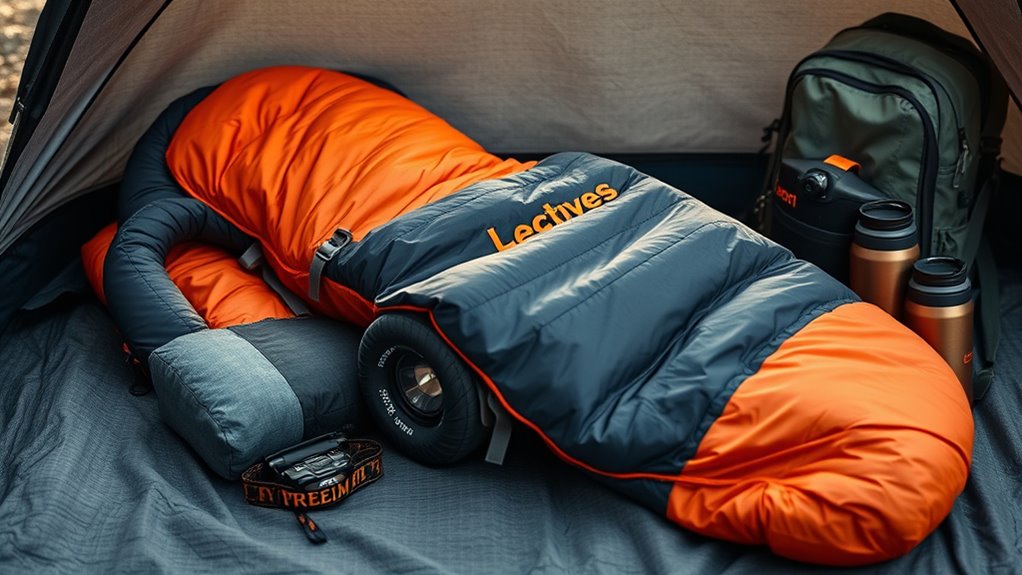
When packing for adventure travel, selecting the right shelter and sleeping equipment is essential to guarantee comfort and safety in unpredictable environments. Your camping tents should be lightweight yet durable, providing protection from bugs and minor weather changes. Sleeping pads are crucial for comfort, insulating you from cold ground and improving sleep quality. Consider the following options:
| Item | Feature | Benefit |
|---|---|---|
| Camping tents | Easy setup, waterproof | Shelter from rain and wind |
| Sleeping pads | Inflatable or foam | Comfort and insulation |
| Tent stakes | Lightweight, strong | Secure tent in wind |
| Sleeping bags | Appropriate temperature ratings | Warmth in varied climates |
| Ground tarps | Extra moisture barrier | Protects tent floor |
Weather Protection Items
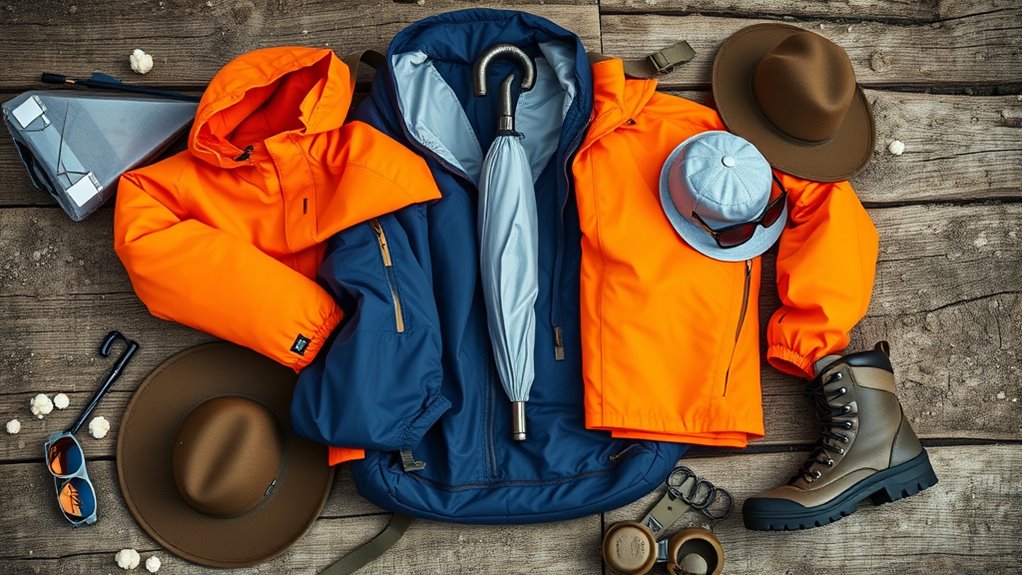
Effective weather protection is vital for successful adventure travel, especially when unpredictable conditions arise. You need reliable gear to stay dry and protected from the sun’s harsh rays. Pack essential items like:
- Lightweight rain gear to keep you dry during sudden downpours
- A waterproof jacket and pants for added coverage
- Sun protection items such as sunscreen, sunglasses, and a wide-brim hat
- Quick-drying, moisture-wicking clothing to adapt to changing weather
- A compact, packable umbrella for unexpected showers or intense sun
Having these items guarantees you can handle rain and shine comfortably. Rain gear helps you stay dry, while sun protection keeps you safe from UV rays. Proper weather protection lets you focus on your adventure without weather-related worries.
Lighting and Power Sources

Good lighting and dependable power sources are essential for staying safe and connected during your adventure. A compact headlamp or flashlight ensures you see clearly in low light or at night, making navigation safer. Consider bringing a portable power bank to keep your devices charged, especially if you’ll be offline for extended periods. Solar panels are a great eco-friendly option; they can recharge your power bank during the day, reducing the need for bulky batteries or outlets. Look for lightweight, durable models suited for outdoor conditions. Having a reliable light source and power backup means you can communicate, take photos, or find your way without worry. Prioritize compact, efficient gear that fits into your pack without adding unnecessary weight.
Personal Items and Accessories
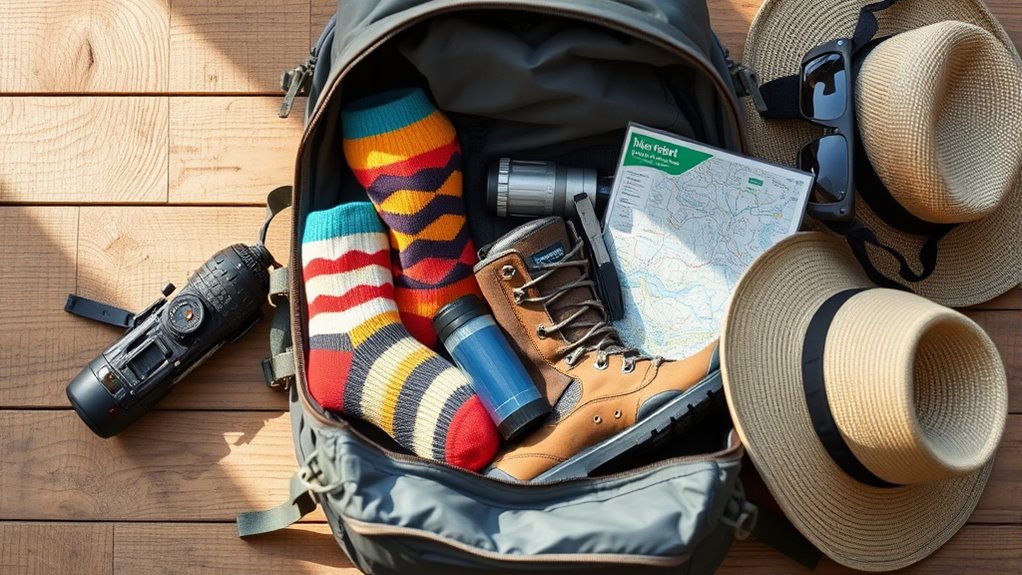
Make sure you pack all your essential identification and travel documents, so you’re ready for checkpoints and accommodations. Consider weather-appropriate accessories like sunglasses, hats, or gloves to stay comfortable in changing conditions. Having these items easily accessible saves you time and keeps your trip running smoothly.
Personal Identification and Documents
Have you packed your essential identification and documents yet? These are vital for smooth travel and safety. Always carry your photo identification, like a driver’s license or passport, and keep your travel documents organized. Consider making copies or digital scans in case originals get lost. Keep everything in a secure, easily accessible location. Here are key items to include:
- Passport and visas
- Travel insurance info
- Photo identification
- Copies of important documents
- Emergency contact info
Having these documents ready prevents delays or issues during your adventure. Double-check that your passport is valid for the entire trip. Keep digital backups on your phone or cloud storage. Properly organizing your ID and documents guarantees a hassle-free experience on your outdoor journey.
Weather-Appropriate Accessories
When preparing for your adventure, paying attention to weather-appropriate accessories guarantees you’re ready for any conditions you encounter. Sun protection is essential, so pack a wide-brim hat, sunglasses, and sunscreen to shield yourself from harmful rays. Depending on the season, include seasonal gear like lightweight gloves or a thermal hat to stay warm or a cooling bandana for hot days. These accessories help you adapt quickly to changing weather and ensure comfort throughout your hike. Don’t forget a waterproof cover for your backpack or a compact rain jacket if rain is forecasted. Properly selected weather accessories keep you protected, boost your confidence, and let you focus on enjoying the outdoors, no matter what Mother Nature throws your way.
Packing Tips and Organization Strategies

Effective packing begins with a clear plan and organized approach, guaranteeing you maximize space and minimize stress. Use packing cubes to compartmentalize your gear, making it easier to find items quickly. Keep toiletry organization simple by using small bags or pouches, preventing leaks and clutter. Fold clothes efficiently to save space and reduce wrinkles. Create a checklist to ensure nothing is forgotten, and pack essentials last for quick access. Consider rolling your clothing instead of folding to save room and prevent creases. Stick to a designated spot for valuables and important documents. Use compression bags for bulky items like jackets. Regularly review your packing list to eliminate unnecessary items. Staying organized keeps your trip smooth and enjoyable from start to finish.
Frequently Asked Questions
How Do I Choose the Right Backpack Size for My Trip?
You should choose a backpack size based on your trip duration and gear needs. Focus on backpack fitting to guarantee comfort and proper weight distribution. For shorter trips, a 15-30 liter pack usually suffices, while longer adventures may require 50+ liters. Use storage capacity tips to pack efficiently—prioritize essentials and avoid overloading. Keep comfort in mind, and select a pack that fits well and offers enough space for your outdoor gear.
What Are the Best Practices for Conserving Battery Life on Devices?
To conserve battery life on your devices, start by lowering screen brightness and turning off unnecessary notifications. Use solar charging when possible to extend your device’s power in outdoor settings, and carry a reliable power bank to recharge on the go. Avoid keeping apps running in the background, and enable battery saver mode. These practices guarantee your devices stay powered longer during your adventure, so you can stay connected and capture memories.
How Can I Prevent Blisters During Long Hikes?
Did you know that up to 70% of long-distance hikers experience blisters? To prevent them, focus on blister prevention techniques like keeping your feet dry and well-lubricated. Selecting proper hiking socks—preferably moisture-wicking and cushioning—also makes a big difference. Make sure your hiking shoes fit well and are broken in before your trip. These steps help minimize friction and pressure, keeping your feet comfortable and blister-free on even the longest hikes.
What Are Eco-Friendly Options for Packing Lightweight Gear?
You can choose eco-friendly options for lightweight gear by selecting items made from sustainable material options like recycled nylon or organic cotton. Opt for biodegradable packing supplies such as compostable bags or biodegradable packing peanuts to reduce waste. By prioritizing these environmentally conscious materials, you help lessen your carbon footprint while keeping your gear lightweight and functional. Always look for certifications to guarantee the products meet eco-friendly standards.
How Do I Manage Waste Responsibly in Remote Areas?
You manage waste responsibly by practicing Leave No Trace principles. Always pack out all waste, including trash, food scraps, and hygiene products, using designated waste disposal methods. Carry reusable bags and containers to reduce single-use items. When in remote areas, find established disposal sites or carry waste with you until proper disposal is available. Respect the environment, minimize impact, and make certain the area stays pristine for others and wildlife alike.
Conclusion
With your gear packed like a symphony of preparedness, you’re ready to embrace nature’s wild canvas. Each item, a brushstroke of confidence, guarantees your adventure flows seamlessly from dawn’s first light to stars’ gentle glow. Trust your packing harmony, and let the spirit of exploration guide you through uncharted waters. Remember, well-packed essentials are your steadfast compass, turning every trail into a masterpiece of discovery and unforgettable memories.



